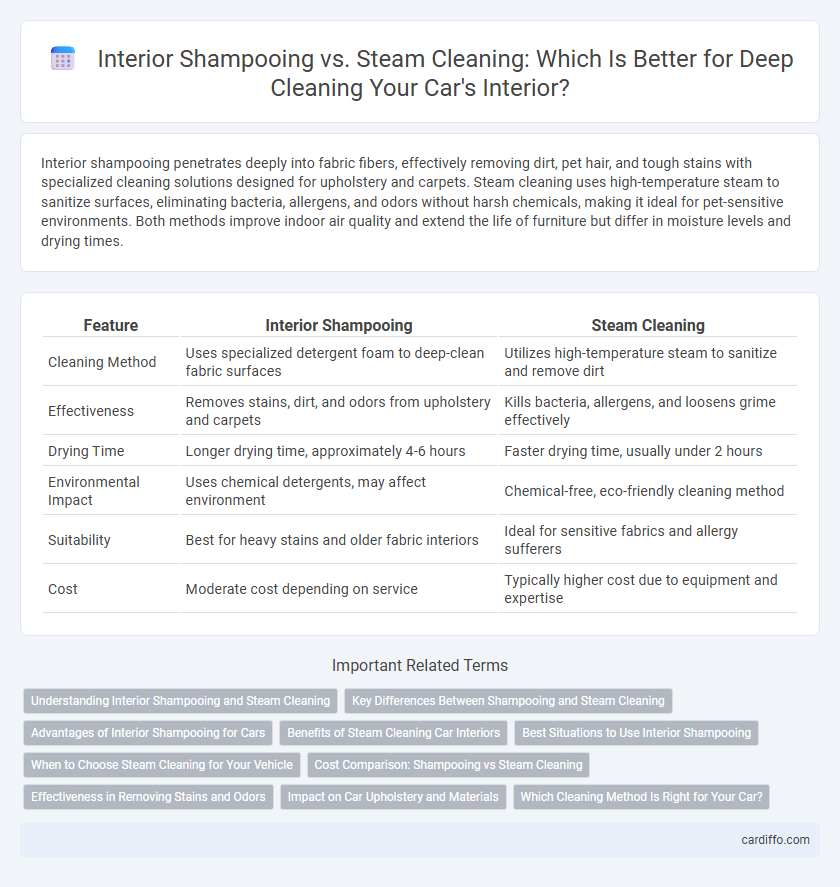Interior shampooing penetrates deeply into fabric fibers, effectively removing dirt, pet hair, and tough stains with specialized cleaning solutions designed for upholstery and carpets. Steam cleaning uses high-temperature steam to sanitize surfaces, eliminating bacteria, allergens, and odors without harsh chemicals, making it ideal for pet-sensitive environments. Both methods improve indoor air quality and extend the life of furniture but differ in moisture levels and drying times.
Table of Comparison
| Feature | Interior Shampooing | Steam Cleaning |
|---|---|---|
| Cleaning Method | Uses specialized detergent foam to deep-clean fabric surfaces | Utilizes high-temperature steam to sanitize and remove dirt |
| Effectiveness | Removes stains, dirt, and odors from upholstery and carpets | Kills bacteria, allergens, and loosens grime effectively |
| Drying Time | Longer drying time, approximately 4-6 hours | Faster drying time, usually under 2 hours |
| Environmental Impact | Uses chemical detergents, may affect environment | Chemical-free, eco-friendly cleaning method |
| Suitability | Best for heavy stains and older fabric interiors | Ideal for sensitive fabrics and allergy sufferers |
| Cost | Moderate cost depending on service | Typically higher cost due to equipment and expertise |
Understanding Interior Shampooing and Steam Cleaning
Interior shampooing involves applying specialized cleaning solutions to fabric surfaces, effectively breaking down dirt, stains, and odors embedded in upholstery fibers. Steam cleaning utilizes high-temperature vapor to sanitize and extract contaminants from interior surfaces, offering a chemical-free alternative that penetrates deeply to eliminate bacteria and allergens. Understanding these methods highlights the choice between deep chemical cleansing and eco-friendly, heat-based sanitization for vehicle or home interiors.
Key Differences Between Shampooing and Steam Cleaning
Interior shampooing uses detergent-based foam to deeply clean upholstery fibers, effectively removing dirt and stains by breaking down oils and grime. Steam cleaning employs high-temperature steam to sanitize surfaces and lift dirt without chemicals, targeting bacteria and allergens for a more hygienic result. The key difference lies in the method: shampooing relies on moisture and detergents, while steam cleaning emphasizes heat and minimal water usage for faster drying times.
Advantages of Interior Shampooing for Cars
Interior shampooing effectively removes deep-seated dirt, stains, and odors from car upholstery, providing a thorough cleaning that revitalizes fabric surfaces. This method penetrates fibers to break down grime and allergens, ensuring a healthier cabin environment compared to surface cleaning techniques. Interior shampooing also enhances the appearance and longevity of car interiors by restoring softness and color vibrancy in seats and carpets.
Benefits of Steam Cleaning Car Interiors
Steam cleaning car interiors effectively removes deep-seated dirt, allergens, and bacteria without the use of harsh chemicals, making it an eco-friendly option. The high-temperature steam penetrates fabric and upholstery fibers, providing superior sanitation and deodorization compared to traditional interior shampooing. This method also accelerates drying times and reduces the risk of mold or residue buildup, enhancing overall vehicle hygiene and longevity.
Best Situations to Use Interior Shampooing
Interior shampooing is most effective for deep-cleaning fabric upholstery and car seats with heavy dirt, stains, or odors, as it penetrates fibers to lift embedded grime. This method is ideal for materials sensitive to moisture or heat because it uses specialized shampoos that minimize damage while restoring fabric texture and color. Interior shampooing excels in scenarios requiring thorough sanitization and deodorization, especially in vehicles frequently exposed to pets, food spills, or smoke.
When to Choose Steam Cleaning for Your Vehicle
Steam cleaning is ideal for vehicles with tough stains, deep-seated dirt, or mold, as it uses high-temperature steam to penetrate and sanitize surfaces without harsh chemicals. Choose steam cleaning for upholstery, carpets, and hard-to-reach areas to ensure effective removal of allergens and bacteria while preserving fabric integrity. This method suits eco-conscious car owners seeking a chemical-free, thorough interior cleaning solution.
Cost Comparison: Shampooing vs Steam Cleaning
Interior shampooing typically costs between $50 and $150, depending on the size and condition of the area, while steam cleaning ranges from $70 to $200, with higher prices reflecting deeper sanitation and faster drying times. Shampooing requires more drying time and may involve additional costs for stain treatments, whereas steam cleaning, using high-temperature vapor, often reduces the need for chemical cleaners and decreases overall labor expenses. Choosing between these methods depends on budget constraints and desired cleanliness levels, with steam cleaning offering long-term value through improved hygiene and quicker turnaround.
Effectiveness in Removing Stains and Odors
Interior shampooing penetrates deep into fabric fibers using specialized detergents to effectively lift and remove stubborn stains and embedded odors, making it ideal for heavily soiled upholstery. Steam cleaning harnesses high-temperature vapor to sanitize and eliminate surface-level dirt and bacteria, reducing allergens and neutralizing odors without the use of chemicals. Both methods excel in their own domain, but for intensive stain removal and odor elimination within porous materials, interior shampooing offers superior results.
Impact on Car Upholstery and Materials
Interior shampooing effectively removes deep stains and embedded dirt from car upholstery fabrics by penetrating fibers with specialized detergents, restoring their original texture and color. Steam cleaning employs high-temperature vapor to sanitize surfaces without harsh chemicals, making it ideal for delicate materials like leather and vinyl while minimizing moisture absorption and drying time. Both methods enhance the longevity of car interiors but differ in their suitability depending on upholstery material and desired cleaning intensity.
Which Cleaning Method Is Right for Your Car?
Interior shampooing effectively removes deep-seated dirt and stains from fabric seats and carpets using specialized cleaning agents, ideal for heavily soiled interiors. Steam cleaning uses high-temperature steam to sanitize and lift dirt from various surfaces, offering a chemical-free solution beneficial for allergy sufferers and delicate materials. Choosing between these methods depends on your car's upholstery type, the extent of dirt, and whether you prioritize deep cleaning or eco-friendly sanitization.
Interior Shampooing vs Steam Cleaning Infographic

 cardiffo.com
cardiffo.com